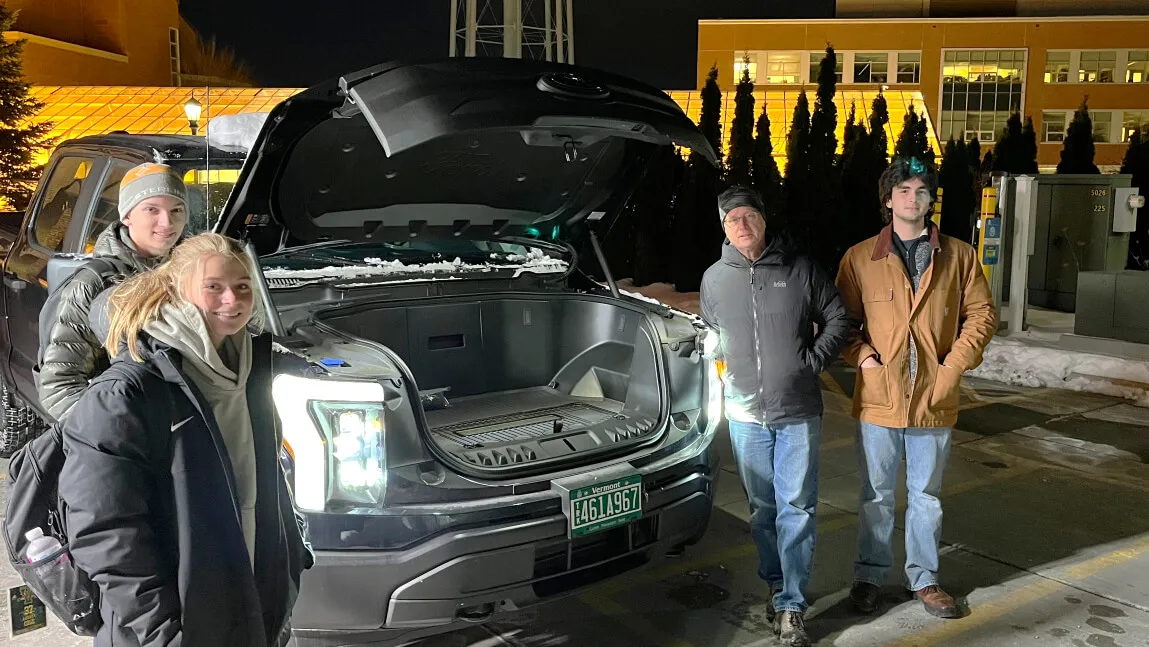The University of Vermont took a leap forward electrifying its fleet last month with the purchase of five electric vehicles which will replace fuel inefficient internal combustion vehicles.
“This is a significant investment in the electrification of our fleet and the first time we’ve had an opportunity to electrify work trucks specifically,” said Abby Bleything, UVM sustainable transportation program manager.
Three new Ford F150 Lightnings and two Ford E-Transit cargo vans arrived on campus in January. The two transit vans will be used by the Physical Plant Department to make routine service visits around campus. The College of Agriculture and Life Sciences, the Rubenstein School of Natural Resources and Transportation and Parking Services have each obtained a new Lightning.
UVM has strengthened its commitment to electric vehicles through a fleet procurement procedure developed by the Office of Sustainability and Transportation and Parking Services in 2019. When departments seek to replace a vehicle, applicants complete a vehicle replacement form asking them to consider alternatively- fueled vehicles along with more efficient conventional internal combustion models.
“It’s a tool to encourage buyers to consider the benefits of vehicles that consume less fossil fuel,” said Bleything. “Increasingly the bottom line, both in terms of operational cost and carbon outputs, suggest that e-vehicles are the way to go.”
Dollars and sense
That’s what Taylor Page, interim director of transportation and parking services at UVM, discovered when he needed to replace an older gas-powered truck. “The cost of the vehicle comes out of our department budget, so price is a big factor. I was shocked at how comparable the price tag was compared to a gas-powered replacement.”
Page’s department will use a new Ford-150 Lightning for jobs like setting up temporary signage in the Gutterson parking lot before hockey or basketball games. “The Lighting has the payload we need to tote all our equipment around. And when it gets cold, our workers can hop inside to warm up without worrying about idling with a gas engine.”
Page is already a believer in going electric—his department has two Nissan LEAFs and one Mitsibushi MiEV in its fleet. One of the vehicles is available to any UVM faculty or staff member who needs a car for business use. He believes the improved performance of electric service vehicles, the growing number of options on the market, and the price point are all converging to make the shift to EVs c a no-brainer, especially when considering savings in gasoline and maintenance.
“There have been supply chain issues over the last few years, but as these vehicles become more available I think we’ll see more and more of them on the road,” he said. Notably, Vermont has committed to 100% of all new cars and light trucks sold in the state to be electric by 2035.
Gary Hawley, a faculty member in the Rubenstein School’s environmental sciences and forestry programs, has been thinking electric since he began leading the green renovation of UVM’s Aiken Center, which received U.S. Green Building Council LEED Platinum status in 2012. He still teaches a course each year called the Greening of Rubenstein. In the class, Hawley and his students consider further energy efficiency steps aimed at achieving carbon net neutrality status for the Rubenstein School.
“Part of that is to make the buildings and vehicles as green as possible,” he said.
When a gas-powered truck was deemed “uninspectable,” Hawley worked with Bleything to find an electric alternative.
“The new truck will be used for field work related to forests and impacts of climate change, water sampling, or wildlife assessments. In the past we rented trucks that might get ten miles to the gallon.”
Hawley is impressed by the performance metrics of the new vehicle, noting it has the same towing capacity as a V-8 diesel. The Lightning will be used to tow small research vessels or transport maintenance equipment to four Vermont forests throughout Vermont managed by the school.
Creating incentives
Like individual drivers in Vermont, UVM can take advantage of a $1800 rebate through the Burlington Electric Department when purchasing an e-vehicle. But as a state university, UVM is not eligible for state incentives available given to individuals for going electric.
Fleet managers on campus told Bleything that up-front costs of an e-vehicle and access to charging stations were the primary barriers. Based on this feedback, Clare Nelson, an intern for TPS and the Office of Sustainability, crafted a successful proposal to the Sustainable Campus Fund to create a $10,000 “incentive bank” for departments looking to make the transition. Each department can receive up to $2000, creating an internal incentive to replace up to five more internal combustion powered service vehicles.
Bleything says the new fund, along with other recent indicatives like installation of idle reduction systems for campus emergency vehicles, wider adoption of e-bikes on campus, and electrifying lawn and grounds equipment, all add up to progress in reducing or mitigating UVM’s reliance on fossil fuels. This commitment will be further solidified by new goals that will be released in the Comprehensive Sustainability Plan, due out later this semester.
“We can’t say we’re all the way or even halfway to having a green campus fleet, but we’re chipping away at it,” she said. “The fact that so many departments are seeing the value in these programs is a real expression of our institution-wide commitment to sustainability.”
